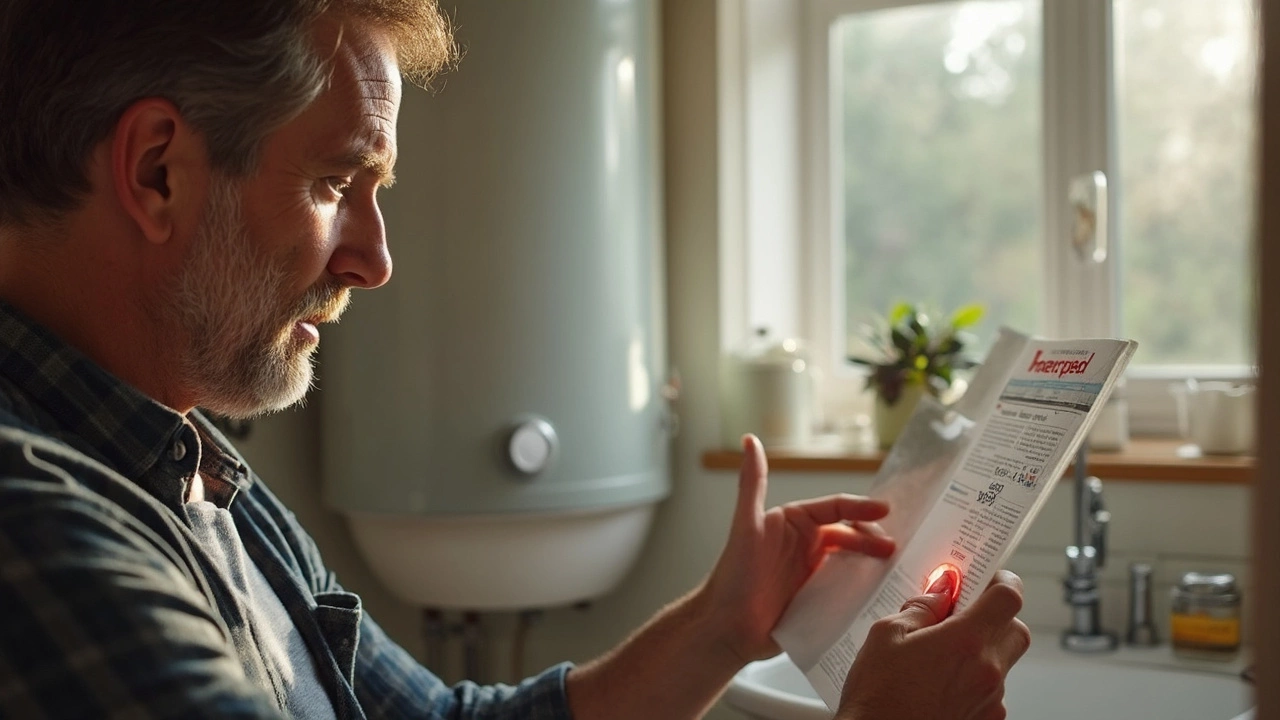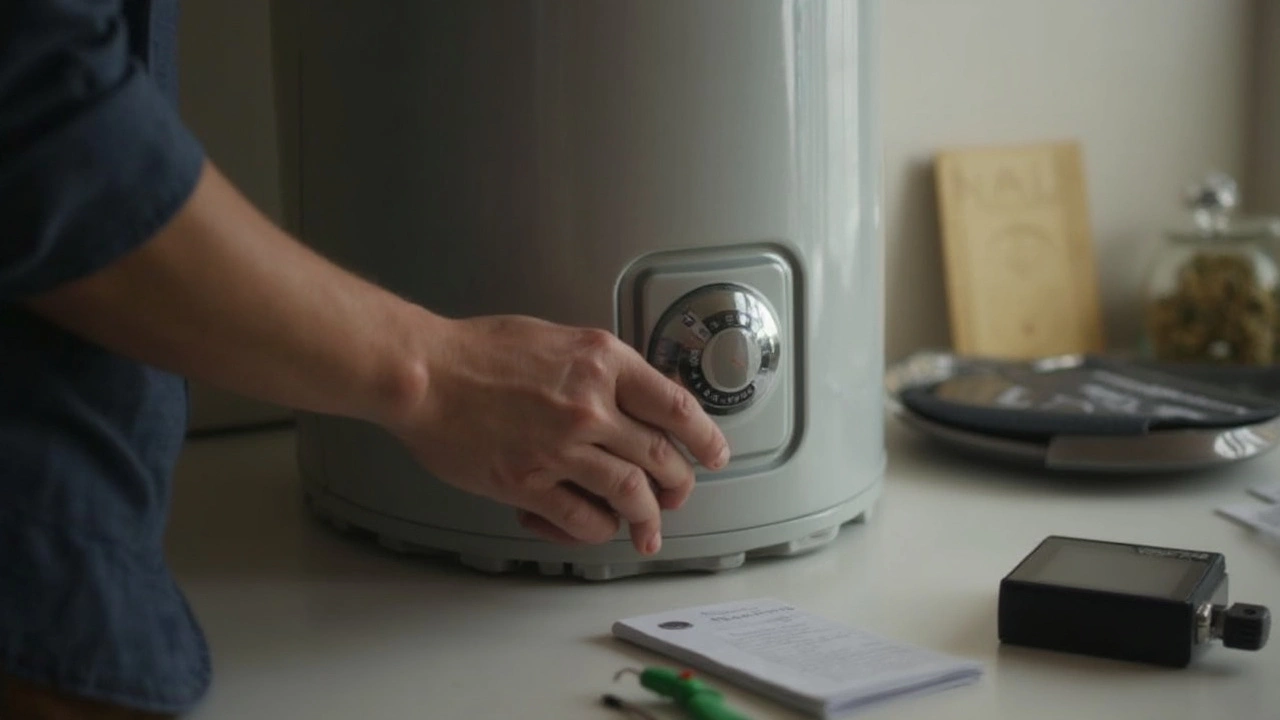
- 24 May 2025
- Gideon Thornton
- 0
Ever stared at a cold shower, wondering how long you’re supposed to press that stubborn water heater reset button? You’re not alone. Most water heaters have a red or black reset button hidden behind a small panel, and pressing it wrong can slow things down—or even make the problem worse.
The trick: don’t hammer the button, but don’t tap it lightning-fast either. For most brands, you just hold it down for 3 to 5 seconds—think “one Mississippi, two Mississippi” up to five. If you don’t hear a click, something’s up. If you’re not sure your heater is actually resetting, don’t stand there longer than you would waiting for a YouTube ad to end. Holding the button forever won’t help (and can sometimes hurt).
Resetting should sort most minor hiccups, but if the button keeps tripping or your water stays icy, there’s usually a deeper reason. Sometimes you’re just one push away from hot water glory. Other days, it’s a sign something else is wrong, like a busted thermostat or a fried heating element.
- What Does the Reset Button Actually Do?
- The Right Way to Press the Reset Button
- Why the Button Trips in the First Place
- Troubleshooting When Reset Doesn’t Work
What Does the Reset Button Actually Do?
The reset button on your water heater is like an emergency cut-off switch. It’s there to protect you and your home when the water heater starts running too hot or if something goes sideways inside the tank. This little button is wired to the thermostat and the unit’s safety system. When the temperature climbs over 170°F (way hotter than your shower should ever get), the reset button “pops” to break the power, shutting everything down so nothing melts or catches fire.
Think of it like a circuit breaker for your hot water. When it trips, it stops the electrical current to your heater. That’s why it won’t keep pumping out hot water until you press the button again. Most modern electric water heaters have this built in; some gas water heaters have a similar safety device, usually called a high-limit switch.
Here’s a quick breakdown of what actually happens when you use the reset button:
- Water temperature spikes way above normal—usually because of a thermostat glitch or a stuck heating element.
- The reset button triggers and cuts power to the heating element.
- The tank cools down to a safe level.
- You push the reset button for a few seconds, power comes back, and the heater starts working again—if there isn’t a bigger problem.
Manufacturers don’t all use the exact same settings, but here’s what’s typical:
| Heater Brand | Reset Temp | Reset Button Location |
|---|---|---|
| Rheem | ~170°F | Upper thermostat panel |
| AO Smith | ~180°F | Behind insulation panel |
| Bradford White | ~170°F | Upper front of tank |
The water heater reset button doesn’t fix every problem—it just turns things back on once it’s safe. If yours keeps tripping, there’s probably something else going on, and it’s a good idea to check out what’s causing the trouble instead of wearing out the button.
The Right Way to Press the Reset Button
Don’t just jab at that button and hope for the best. There’s an actual right way to press the reset button on your water heater, and getting it wrong can leave you stuck with cold showers for longer than anyone wants. Here’s how you do it properly so your water heater gets the message:
- First, turn off the breaker to your water heater. This makes sure you’re not dealing with any shocks while working with the panel.
- Next, pop open the metal access panel on your heater. There’s usually a layer of insulation right behind it, so pull that out to see the reset button clearly.
- The reset button is usually bright red or sometimes black, usually close to the thermostat.
- With dry fingers, press the reset button firmly and hold it down for 3-5 seconds—not longer. Listen for a click. That’s the sign you did it right.
- Close up the insulation and panel. Flip the breaker back on, then wait up to 30 minutes for hot water (electric heaters), or just a few minutes with gas models.
Lots of folks either tap the button too quickly or hold it way too long, but factory instructions (especially from top brands like Rheem and AO Smith) are pretty clear: about 3 to 5 seconds is ideal. If your heater doesn’t click or won’t reset after a few tries, don’t keep pressing. That won’t fix it, and you’re better off checking for other issues.
Check out this quick guide on how popular water heater brands usually handle the reset process:
| Brand | Button Color | Hold Duration (Seconds) | Reset Location |
|---|---|---|---|
| Rheem | Red | 3-5 | Above upper thermostat |
| AO Smith | Red | 3-5 | Near heating element |
| Bradford White | Black | 3 | Above upper element |
Avoid using tools or sharp objects if your finger doesn’t fit—pushing with anything else can damage the button. And one last thing: only try this two or three times max. If nothing changes, you probably need to check for larger problems or call out a pro.

Why the Button Trips in the First Place
When your water heater reset button pops out, it’s not just being dramatic—it’s trying to tell you something’s off. That button, also known as the high-limit switch, is basically your heater’s safety net. Its job? Cut the power if the water gets way too hot inside the tank.
Here’s what usually sets it off:
- Faulty thermostat: Your thermostat tells the heating element when to turn on or off. If it sticks on “hot,” the water temperature skyrockets, tripping the reset button.
- Heating element issues: Burnt-out or broken heating elements can sometimes short-circuit, causing the tank to overheat and making the reset button do its thing.
- Electrical problems: Loose connections or bad wiring can create random power surges that trip the reset mechanism as a precaution.
- Mineral buildup: In areas with hard water, minerals pile up on the elements. This causes them to work harder and can overheat the tank faster than it should.
- Old age: Let’s face it, after about 8-12 years, most water heaters start acting up. Worn components can trigger the reset even if nothing looks wildly wrong.
Here’s a look at why water heater reset buttons trip most often, based on recent repair reports:
| Cause | Chance of Triggering Reset |
|---|---|
| Thermostat issue | 40% |
| Heating element failure | 25% |
| Electrical/wiring problems | 20% |
| Mineral buildup | 10% |
| Other/unknown | 5% |
If you’re always resetting, don’t ignore it. Frequent tripping means your heater is basically waving a red flag. It’s usually an easy fix—like changing a thermostat or cleaning out mineral gunk—but if you always have to hit that reset button, it’s time to troubleshoot or call a pro before things get worse.
Troubleshooting When Reset Doesn’t Work
So, you’ve pressed the reset button, waited the right amount of time, and still—no hot water? Time to dig a little deeper. This is usually a sign that something in your water heater needs serious attention. Don’t worry, most of these issues are common and fixable.
First off, let’s look at what might be going wrong:
- Tripped breaker or blown fuse: Sometimes, the issue isn’t in the heater at all, but your electrical panel. Check your breaker box and reset the breaker for your water heater, or swap a blown fuse if needed.
- Bad thermostat: Electric water heaters usually have two thermostats. If either one is malfunctioning, the reset button keeps tripping. These usually need replacing rather than repairing.
- Faulty heating element: These get old and burn out, especially in hard water areas. If the water is still cold and the reset trips again, a busted element is a good bet.
- Loose wiring: Sometimes wires inside the heater can overheat or shake loose. This is not a DIY fix—call a pro if you see burned wires or smell something weird.
- Leaking: Spots of water around the heater or on the floor point to leaks. Even slow leaks can mess with the internal electronics.
Here’s a quick table that breaks down the most common reasons your water heater might ignore the reset command:
| Problem | How Often It Happens | Signs |
|---|---|---|
| Tripped Breaker | Very Common (40% of electrical issues) | No power, reset won’t work at all |
| Thermostat Fails | Common, especially over 10 years old | Warm water stalls, reset trips again |
| Heating Element Burnout | Frequent with hard water | No hot water ever, reset useless |
| Loose/Burnt Wiring | Less Common | Burning smell, odd noises |
| Leaks | Regular with older tanks | Water on floor, rusty stains |
If you’ve checked or handled these basics, but your heater is still down, it’s time to call a trusted plumber or licensed electrician. Working on wiring inside a water heater can get dangerous fast, especially if you’re not sure what you’re doing.
Pro tip: If your heater’s reset button keeps tripping more than once a month, don’t just keep pressing it—fix the real problem. Constant resets are a red flag there’s a bigger safety issue at play.




